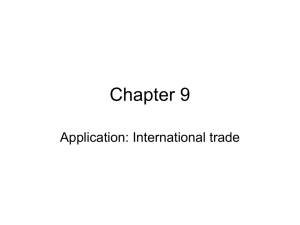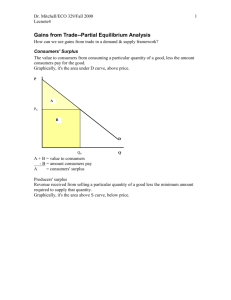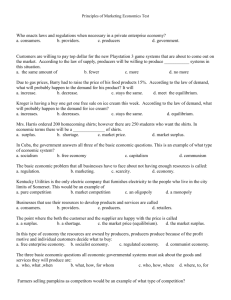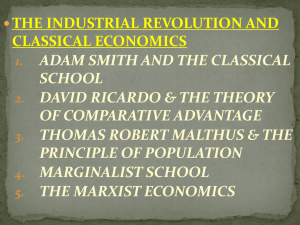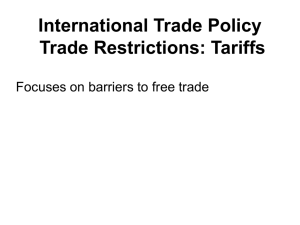New Microsoft Office..
advertisement
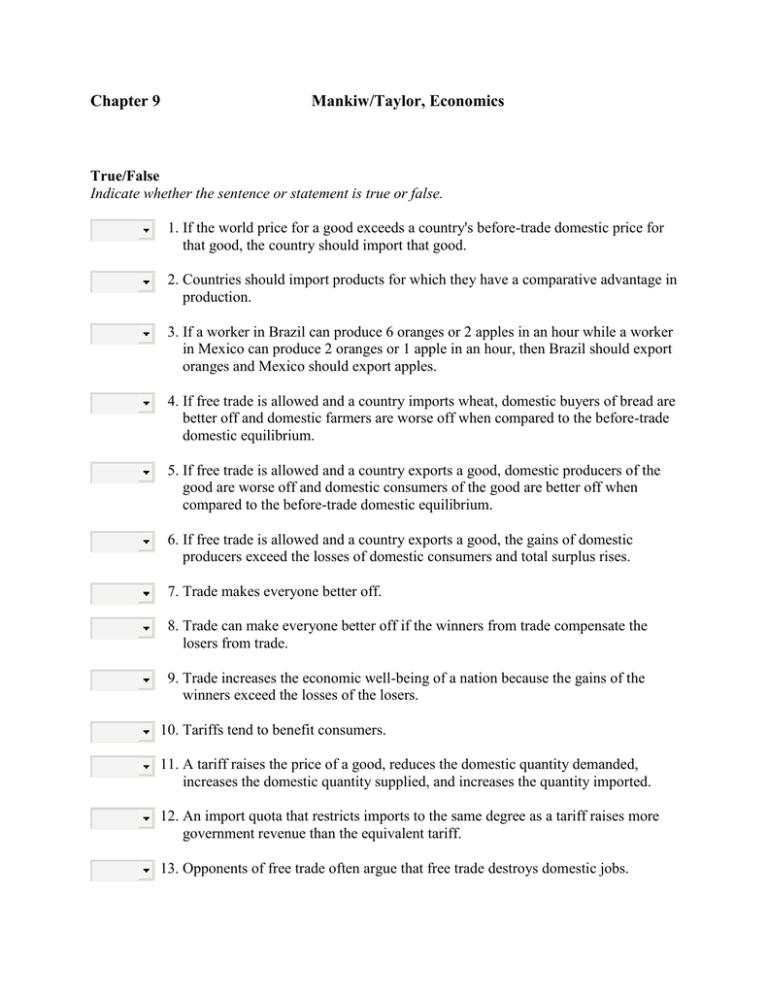
Chapter 9 Mankiw/Taylor, Economics True/False Indicate whether the sentence or statement is true or false. 1. If the world price for a good exceeds a country's before-trade domestic price for that good, the country should import that good. 2. Countries should import products for which they have a comparative advantage in production. 3. If a worker in Brazil can produce 6 oranges or 2 apples in an hour while a worker in Mexico can produce 2 oranges or 1 apple in an hour, then Brazil should export oranges and Mexico should export apples. 4. If free trade is allowed and a country imports wheat, domestic buyers of bread are better off and domestic farmers are worse off when compared to the before-trade domestic equilibrium. 5. If free trade is allowed and a country exports a good, domestic producers of the good are worse off and domestic consumers of the good are better off when compared to the before-trade domestic equilibrium. 6. If free trade is allowed and a country exports a good, the gains of domestic producers exceed the losses of domestic consumers and total surplus rises. 7. Trade makes everyone better off. 8. Trade can make everyone better off if the winners from trade compensate the losers from trade. 9. Trade increases the economic well-being of a nation because the gains of the winners exceed the losses of the losers. 10. Tariffs tend to benefit consumers. 11. A tariff raises the price of a good, reduces the domestic quantity demanded, increases the domestic quantity supplied, and increases the quantity imported. 12. An import quota that restricts imports to the same degree as a tariff raises more government revenue than the equivalent tariff. 13. Opponents of free trade often argue that free trade destroys domestic jobs. 14. If a foreign country subsidizes its export industries, its tax payers are paying to improve the welfare of consumers in the importing countries. 15. Tariffs and quotas cause deadweight losses because they raise the price of the imported good and cause over-production and under-consumption of the good in the importing country. Multiple Choice Identify the letter of the choice that best completes the statement or answers the question. 16. If free trade is allowed, a country will export a good if the world price is a. above the before-trade domestic price of the good. b. below the before-trade domestic price of the good. c. equal to the before-trade domestic price of the good. d. none of these answers 17. Suppose the world price is below the before-trade domestic price for a good. If a country allows free trade in this good, a. both producers and consumers will gain. b. both producers and consumers will lose. c. producers will gain and consumers will lose. d. consumers will gain and producers will lose. 18. The following table shows the amount of output a worker can produce per hour in Germany and Poland. Germany Poland Pens 8 8 Pencils 4 2 Which of the following statements about free trade between Germany and Poland is true? a. Germany will export pencils and Poland will export pens. b. Germany will export pens and Poland will export pencils. c. Germany will export both pens and pencils. d. Germany will export pencils but there will be no trade in pens because neither country has a comparative advantage in the production of pens. 19. If the world price for a good exceeds the before-trade domestic price for a good, then that country must have a. a comparative disadvantage in the production of the good. b. an absolute disadvantage in the production of the good. c. an absolute advantage in the production of the good. d. a comparative advantage in the production of the good. 20. Refer to Exhibit 6. If trade is not allowed, consumer surplus is the area a. b. c. d. e. A + B + C + D. A. A + B + C. A + B + D. A + B. 21. Refer to Exhibit 6. If free trade is allowed, consumer surplus is the area a. b. c. d. A + B + C + D. A. A + B + D. A + B + C. e. A + B. 22. Refer to Exhibit 6. If trade is not allowed, producer surplus is the area a. b. c. d. e. A + B + C + D. A + B + C. B + C + D. C. B + C. 23. Refer to Exhibit 6. If free trade is allowed, producer surplus is the area a. B + C + D. b. A + B + C. c. B + C. d. A + B + C + D. e. C. 24. Refer to Exhibit 6. The gains from trade correspond to the area a. b. c. d. e. B. D. C. B + D. A. 25. When a country allows trade and exports a good, a. domestic consumers are better off, domestic producers are worse off, and the nation is worse off because the losses of the losers exceed the gains of the winners. b. domestic consumers are better off, domestic producers are worse off, and the nation is better off because the gains of the winners exceed the losses of the losers. c. domestic producers are better off, domestic consumers are worse off, and the nation is worse off because the losses of the losers exceed the gains of the winners. d. domestic producers are better off, domestic consumers are worse off, and the nation is better off because the gains of the winners exceed the losses of the losers. 26. When a country allows trade and imports a good, a. domestic producers are worse off, domestic consumers are better off, and the nation is worse off because the losses of the losers exceed the gains of the winners. b. domestic consumers are worse off, domestic producers are better off, and the nation is worse off because the losses of the losers exceed the gains of the winners. c. domestic producers are worse off, domestic consumers are better off, and the nation is better off because the gains of the winners exceed the losses of the losers. d. domestic consumers are worse off, domestic producers are better off, and the nation is better off because the gains of the winners exceed the losses of the losers. 27. Refer to Exhibit 7. If free trade is allowed, consumer surplus is the area a. b. c. d. e. A + B + C + D + E + F + G. A + B. A + B + C + D + E + F. A. A + B + C. 28. Refer to Exhibit 7. If a tariff is placed on this good, consumer surplus is the area a. b. c. d. e. A + B + C. A + B + C + D + E + F + G. A + B. A + B + C + D + E + F. A. 29. Refer to Exhibit 7. Government revenue from the tariff is the area a. b. c. d. e. D + F. G. E. D + E + F. C + D + E + F. 30. Refer to Exhibit 7. If a tariff is placed on this good, producer surplus is the area a. b. c. d. e. G. G + C + D + E + F + B. G + C. G + C + E. G + C + D + E + F. 31. Refer to Exhibit 7. The deadweight loss from the tariff is the area a. b. c. d. e. D + F. E. D + E + F. B + D + E + F. B. 32. Which of the following statements about a tariff is true? a. A tariff increases producer surplus, decreases consumer surplus, increases revenue to the government, and increases total surplus. b. A tariff increases consumer surplus, decreases producer surplus, increases revenue to the government, and reduces total surplus. c. A tariff increases producer surplus, decreases consumer surplus, increases revenue to the government, and reduces total surplus. d. A tariff increases consumer surplus, decreases producer surplus, increases revenue to the government, and increases total surplus. 33. Which of the following statements about import quotas is true? a. Voluntary quotas established by the exporting country reduce the importing country's deadweight loss from the trade restriction. b. An import quota reduces the price to the domestic consumers. c. Which of the following statements about import quotas is true? d. Import quotas are preferred to tariffs because they raise more revenue for the imposing government. 34. Which of the following is not employed as an argument in support of trade restrictions? a. Free trade harms the national security if vital products are imported. b. Free trade is harmful to importing countries if foreign countries subsidize their exporting industries. c. Free trade destroys domestic jobs. d. Free trade harms both domestic producers and domestic consumers and therefore reduces total surplus. e. Free trade harms infant industries in an importing country. 35. Because producers are better able to organize than consumers, we would expect there to be political pressure to create a. export restrictions. b. import restrictions. c. free trade. d. none of these answers. Chapter 9 Mankiw/Taylor, Economics True/False Indicate whether the sentence or statement is true or false. 1. If the world price for a good exceeds a country's before-trade domestic price for that good, the country should import that good. ANSWER: F POINTS: 0 / 1 2. Countries should import products for which they have a comparative advantage in production. ANSWER: F POINTS: 0 / 1 3. If a worker in Brazil can produce 6 oranges or 2 apples in an hour while a worker in Mexico can produce 2 oranges or 1 apple in an hour, then Brazil should export oranges and Mexico should export apples. ANSWER: T POINTS: 0 / 1 4. If free trade is allowed and a country imports wheat, domestic buyers of bread are better off and domestic farmers are worse off when compared to the before-trade domestic equilibrium. ANSWER: T POINTS: 0 / 1 5. If free trade is allowed and a country exports a good, domestic producers of the good are worse off and domestic consumers of the good are better off when compared to the before-trade domestic equilibrium. ANSWER: F POINTS: 0 / 1 6. If free trade is allowed and a country exports a good, the gains of domestic producers exceed the losses of domestic consumers and total surplus rises. ANSWER: T POINTS: 0 / 1 7. Trade makes everyone better off. ANSWER: F POINTS: 0 / 1 8. Trade can make everyone better off if the winners from trade compensate the losers from trade. ANSWER: T POINTS: 0 / 1 9. Trade increases the economic well-being of a nation because the gains of the winners exceed the losses of the losers. ANSWER: T POINTS: 0 / 1 10. Tariffs tend to benefit consumers. ANSWER: F POINTS: 0 / 1 11. A tariff raises the price of a good, reduces the domestic quantity demanded, increases the domestic quantity supplied, and increases the quantity imported. ANSWER: F POINTS: 0 / 1 12. An import quota that restricts imports to the same degree as a tariff raises more government revenue than the equivalent tariff. ANSWER: F POINTS: 0 / 1 13. Opponents of free trade often argue that free trade destroys domestic jobs. ANSWER: T POINTS: 0 / 1 14. If a foreign country subsidizes its export industries, its tax payers are paying to improve the welfare of consumers in the importing countries. ANSWER: T POINTS: 0 / 1 15. Tariffs and quotas cause deadweight losses because they raise the price of the imported good and cause over-production and under-consumption of the good in the importing country. ANSWER: T POINTS: 0 / 1 Multiple Choice Identify the letter of the choice that best completes the statement or answers the question. 16. If free trade is allowed, a country will export a good if the world price is a. above the before-trade domestic price of the good. b. below the before-trade domestic price of the good. c. equal to the before-trade domestic price of the good. d. none of these answers ANSWER: A POINTS: 0 / 1 17. Suppose the world price is below the before-trade domestic price for a good. If a country allows free trade in this good, a. both producers and consumers will gain. b. both producers and consumers will lose. c. producers will gain and consumers will lose. d. consumers will gain and producers will lose. ANSWER: D POINTS: 0 / 1 18. The following table shows the amount of output a worker can produce per hour in Germany and Poland. Germany Poland Pens 8 8 Pencils 4 2 Which of the following statements about free trade between Germany and Poland is true? a. Germany will export pencils and Poland will export pens. b. Germany will export pens and Poland will export pencils. c. Germany will export both pens and pencils. d. Germany will export pencils but there will be no trade in pens because neither country has a comparative advantage in the production of pens. ANSWER: A POINTS: 0 / 1 19. If the world price for a good exceeds the before-trade domestic price for a good, then that country must have a. a comparative disadvantage in the production of the good. b. an absolute disadvantage in the production of the good. c. an absolute advantage in the production of the good. d. a comparative advantage in the production of the good. ANSWER: D POINTS: 0 / 1 20. Refer to Exhibit 6. If trade is not allowed, consumer surplus is the area a. b. c. d. e. A + B + C + D. A. A + B + C. A + B + D. A + B. ANSWER: E POINTS: 0 / 1 21. Refer to Exhibit 6. If free trade is allowed, consumer surplus is the area a. b. c. d. e. A + B + C + D. A. A + B + D. A + B + C. A + B. ANSWER: B POINTS: 0 / 1 22. Refer to Exhibit 6. If trade is not allowed, producer surplus is the area a. b. c. d. e. A + B + C + D. A + B + C. B + C + D. C. B + C. ANSWER: D POINTS: 0 / 1 23. Refer to Exhibit 6. If free trade is allowed, producer surplus is the area a. b. c. d. e. B + C + D. A + B + C. B + C. A + B + C + D. C. ANSWER: A POINTS: 0 / 1 24. Refer to Exhibit 6. The gains from trade correspond to the area a. b. c. d. B. D. C. B + D. e. A. ANSWER: B POINTS: 0 / 1 25. When a country allows trade and exports a good, a. domestic consumers are better off, domestic producers are worse off, and the nation is worse off because the losses of the losers exceed the gains of the winners. b. domestic consumers are better off, domestic producers are worse off, and the nation is better off because the gains of the winners exceed the losses of the losers. c. domestic producers are better off, domestic consumers are worse off, and the nation is worse off because the losses of the losers exceed the gains of the winners. d. domestic producers are better off, domestic consumers are worse off, and the nation is better off because the gains of the winners exceed the losses of the losers. ANSWER: D POINTS: 0 / 1 26. When a country allows trade and imports a good, a. domestic producers are worse off, domestic consumers are better off, and the nation is worse off because the losses of the losers exceed the gains of the winners. b. domestic consumers are worse off, domestic producers are better off, and the nation is worse off because the losses of the losers exceed the gains of the winners. c. domestic producers are worse off, domestic consumers are better off, and the nation is better off because the gains of the winners exceed the losses of the losers. d. domestic consumers are worse off, domestic producers are better off, and the nation is better off because the gains of the winners exceed the losses of the losers. ANSWER: C POINTS: 0 / 1 27. Refer to Exhibit 7. If free trade is allowed, consumer surplus is the area a. b. c. d. e. A + B + C + D + E + F + G. A + B. A + B + C + D + E + F. A. A + B + C. ANSWER: C POINTS: 0 / 1 28. Refer to Exhibit 7. If a tariff is placed on this good, consumer surplus is the area a. b. c. d. e. A + B + C. A + B + C + D + E + F + G. A + B. A + B + C + D + E + F. A. ANSWER: C POINTS: 0 / 1 29. Refer to Exhibit 7. Government revenue from the tariff is the area a. b. c. d. e. D + F. G. E. D + E + F. C + D + E + F. ANSWER: C POINTS: 0 / 1 30. Refer to Exhibit 7. If a tariff is placed on this good, producer surplus is the area a. b. c. d. e. G. G + C + D + E + F + B. G + C. G + C + E. G + C + D + E + F. ANSWER: C POINTS: 0 / 1 31. Refer to Exhibit 7. The deadweight loss from the tariff is the area a. b. c. d. e. D + F. E. D + E + F. B + D + E + F. B. ANSWER: A POINTS: 0 / 1 32. Which of the following statements about a tariff is true? a. A tariff increases producer surplus, decreases consumer surplus, increases revenue to the government, and increases total surplus. b. A tariff increases consumer surplus, decreases producer surplus, increases revenue to the government, and reduces total surplus. c. A tariff increases producer surplus, decreases consumer surplus, increases revenue to the government, and reduces total surplus. d. A tariff increases consumer surplus, decreases producer surplus, increases revenue to the government, and increases total surplus. ANSWER: C POINTS: 0 / 1 33. Which of the following statements about import quotas is true? a. Voluntary quotas established by the exporting country reduce the importing country's deadweight loss from the trade restriction. b. An import quota reduces the price to the domestic consumers. c. Which of the following statements about import quotas is true? d. Import quotas are preferred to tariffs because they raise more revenue for the imposing government. ANSWER: C POINTS: 0 / 1 34. Which of the following is not employed as an argument in support of trade restrictions? a. Free trade harms the national security if vital products are imported. b. Free trade is harmful to importing countries if foreign countries subsidize their exporting industries. c. Free trade destroys domestic jobs. d. Free trade harms both domestic producers and domestic consumers and therefore reduces total surplus. e. Free trade harms infant industries in an importing country. ANSWER: D POINTS: 0 / 1 35. Because producers are better able to organize than consumers, we would expect there to be political pressure to create a. export restrictions. b. import restrictions. c. free trade. d. none of these answers. ANSWER: B POINTS: 0 / 1


